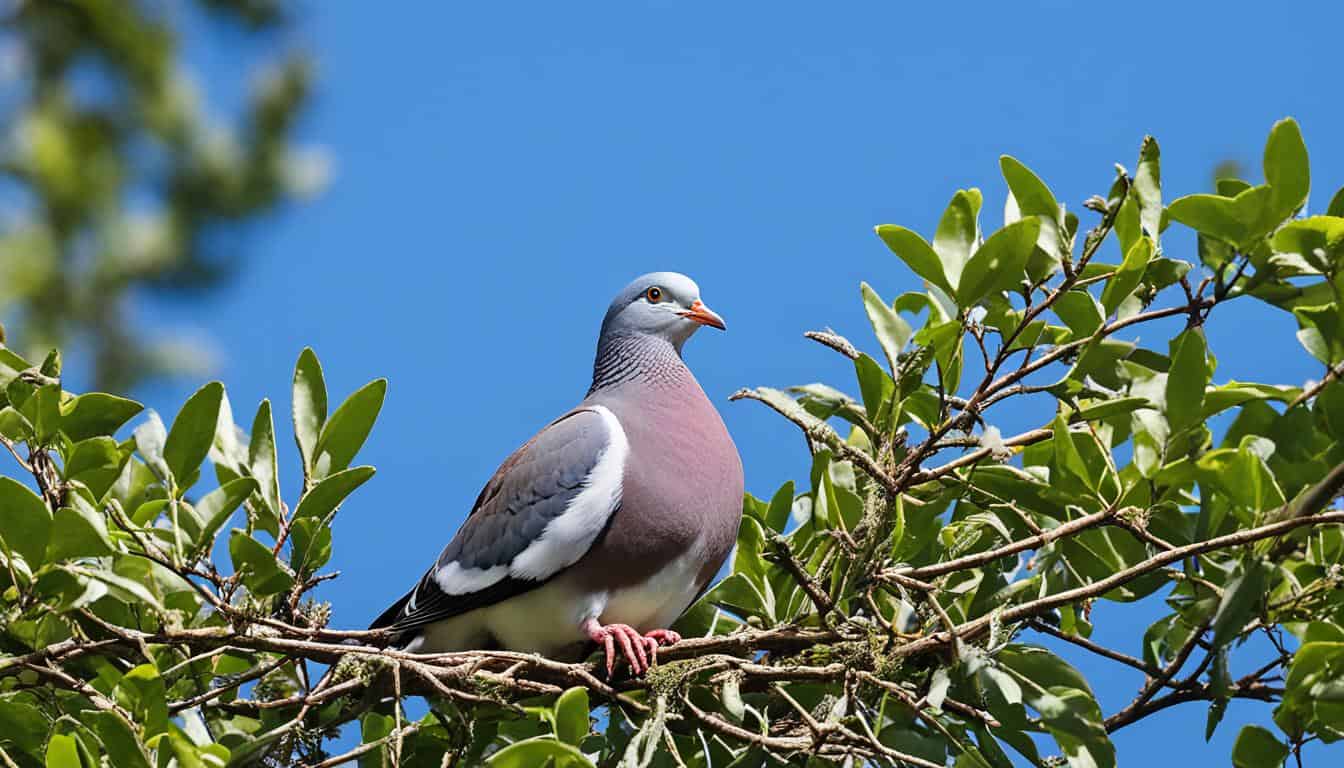Common Woodpigeon (Columba palumbus) ID Guide
Did you know the Common Woodpigeon is Europe’s biggest dove and pigeon? It’s a common bird but can be hard to spot for beginners. This guide will show you how to easily identify the Common Woodpigeon by its looks and actions.
The Common Woodpigeon stands out with its grey color and white patches on the neck. Adults have these white patches, while young ones don’t. It also has a wide, dark tail and dark grey wings. The wings of the Common Woodpigeon don’t have much contrast, unlike the Stock Dove. Males are usually bigger than females.
Introduction to the Common Woodpigeon
The Common Woodpigeon is a big bird that lives in the western Palearctic region. It has grey feathers with a pinkish breast. You can see it in Europe and parts of Asia. It loves living in cities and often gathers in big groups outside of breeding season.
Overview and Significance
This bird is important in the bird world. It helps spread seeds and keeps nature in balance. Its fast flight is easy to spot, with steady wing beats and quick flicks.
The Common Woodpigeon is known for being adaptable and important for agriculture. It also holds a special place in many cultures where it lives.
As part of the Columbidae family, the Common Woodpigeon shares a name with other doves and pigeons. Its scientific name, Columba palumbus, shows its place in the bird world. This bird means a lot to people, not just in nature but also in culture and symbols.
“The Common Woodpigeon is a remarkable bird, with its striking appearance and ability to thrive in both rural and urban environments. Its presence is a testament to the resilience and adaptability of nature.”
Physical Appearance and Key Identifiers
The common woodpigeon stands out with its unique looks and size. It’s a bird that catches the eye easily. Let’s take a closer look at what makes it special.
Distinctive Markings and Coloration
Adult common woodpigeons have green and white patches on their necks. This makes them look stunning. Their chest is a bright pink, adding to their beauty. Their eyes are a pale yellow, making them even more striking.
Juvenile birds are different. They don’t have white neck patches. They have a greyer beak and lighter grey feathers.
Size Comparisons and Measurements
The common woodpigeon is a big bird. Males are bigger than females, showing how different they can be. Knowing about the woodpigeon’s physical features, markings, and size comparisons helps birders tell them apart from other pigeons.
| Measurement | Male Woodpigeon | Female Woodpigeon |
|---|---|---|
| Length | 40-43 cm | 37-40 cm |
| Wingspan | 75-80 cm | 70-75 cm |
| Weight | 400-500 g | 350-450 g |
Sound and Vocalizations
The common woodpigeon, also known as the woodpigeon, is famous for its unique sounds. Its call is a loud, deep cooing sound, often heard as “coo-COO-COO-coo-coo.” This woodpigeon sound is a key feature of the species and is often heard before the bird is seen.
Birders and nature lovers use mnemonics to remember the woodpigeon song. A common one is “Take two cows, Teddy,” which helps capture the common woodpigeon calls‘ rhythm. The bird’s sounds are crucial for its behavior and communication. They help mark territory, attract mates, and keep social bonds within groups.
Aside from the cooing call, the woodpigeon makes other vocalizations. These include a low, grunting sound, a croaking alarm call, and a whistling sound when flying. These woodpigeon sounds are key to the bird’s communication with others.
“The call of the common woodpigeon is one of the most recognizable sounds in the natural world, a soothing yet distinctive cooing that has been interpreted in countless ways by birders and nature enthusiasts alike.”
Learning about the common woodpigeon calls and woodpigeon sounds can make enjoying this bird more rewarding. It helps us appreciate this common yet often overlooked species.
Habitat and Distribution
The Common Woodpigeon (Columba palumbus) lives in many places. They love woodpigeon habitat like dense forests and urban parks. This shows how well they adapt to different places. They can be found from Europe to western Siberia and Iraq, and even in Northwest Africa to the Azores.
They also live in Iran, Turkmenistan, Kazakhstan, western China, northwestern India, and Nepal. This shows how wide their woodpigeon range is.
Range and Migration Patterns
The woodpigeon distribution covers a huge area. But, they move seasonally. In southern and western Europe, they stay all year. But in the north and east, they migrate to warmer places in winter.
“The Common Woodpigeon has proven its versatility, thriving in a wide range of environments, from dense forests to urban landscapes. Its extensive woodpigeon distribution and woodpigeon migration patterns reflect the species’ remarkable adaptability to diverse habitats and climates.”
- The woodpigeon habitat includes forests, woodlands, parks, and gardens.
- Woodpigeon distribution ranges from Europe to western Siberia and Iraq, and from Northwest Africa to the Azores, Iran, Turkmenistan, Kazakhstan, western China, northwestern India, and Nepal.
- In the southern and western parts of Europe, the Common Woodpigeon is a resident species, while in the colder northern and eastern regions, it is migratory, undertaking woodpigeon migration to find more favorable conditions during the winter months.
Common Woodpigeon Behavior
The common woodpigeon, Columba palumbus, stands out with its unique behaviors. It is a social bird that loves to be around others. During the non-breeding season, it forms large groups.
Gregarious Nature and Flocking
Woodpigeons are very social and often come together in big groups. These groups can have a few dozen to hundreds of birds. They do this for safety and to find food together.
Territorial Defense and Displays
When it’s time to breed, male woodpigeons get very protective of their areas. They use eye-catching displays to show they’re in charge. These displays help them keep their homes safe for mating and raising young.
Woodpigeons also have a special way of flying. They flap their wings fast and flick them sometimes. This lets them move quickly and easily through the air. They use this skill to find food or get away from danger.
“The common woodpigeon’s social nature and territorial displays are an integral part of its survival strategy, allowing it to thrive in diverse habitats across its extensive range.”
Breeding and Nesting Habits
The Common Woodpigeon is a bird with unique looks and a beautiful sound. It lives in Europe and parts of Asia. Their breeding and nesting habits are fascinating and important to know.
Woodpigeons build their nests in tree branches. They use twigs and sticks to make a strong nest. This nest is where the female lays two white eggs. The male and female take turns sitting on the eggs for 17 to 19 days.
After the eggs hatch, the chicks need constant care. They learn to fly around 33 to 34 days old. If their nest is disturbed, they can survive from 20 days old.
The way Common Woodpigeons breed and nest is key to their survival. Knowing about their behavior helps us value nature’s balance. It shows how important woodpigeons are in their ecosystems.

| Nesting Behavior | Egg Incubation | Chick Development |
|---|---|---|
| Nest construction in tree branches | 17-19 days | First flight at 33-34 days |
| Clutch size: 2 white eggs | Both parents take turns incubating | Can survive as early as 20 days if disturbed |
Diet and Feeding Preferences
The common woodpigeon, also known as the European wood pigeon, eats a wide variety of foods. They mainly eat plants like leaves, shoots, and seeds. They also enjoy fruits, nuts, and berries. Sometimes, they eat insects, ants, and small worms to get more nutrients.
Foraging Behavior and Food Sources
Woodpigeons have different ways to find food. They use their strong beaks to pick up food from the ground. They also visit fields, gardens, and forests to find food.
These birds eat many crops like cereals, oilseeds, and vegetables. This can sometimes cause problems for farmers. But, they help the ecosystem by spreading seeds and helping plants pollinate.
Woodpigeons need water to drink and bathe in. Having water around is important for their health and happiness.
| Food Type | Proportion of Diet |
|---|---|
| Leaves, shoots, and seedlings | 40% |
| Grains, nuts, fruits, and berries | 50% |
| Larvae, ants, and small worms | 10% |
Woodpigeons eat a lot of different foods and can live in many places. This helps them do well in the wild.
“Woodpigeons are remarkable in their ability to take advantage of a wide range of food sources, from cultivated crops to natural vegetation. This versatility is a key factor in their success as a species.”
Conservation Status and Threats
The Common Woodpigeon is listed as Least Concern by the International Union for Conservation of Nature (IUCN). This is because it has a stable population and lives in many places across Europe, Asia, and North Africa. Its ability to live in different places has helped it survive.
But, the woodpigeon faces some big challenges. Several woodpigeon threats could affect its future. Habitat loss and fragmentation are big worries, especially in areas getting more urban and agricultural.
Key Threats to the Woodpigeon
- Habitat loss and fragmentation due to urbanization and agricultural expansion
- Hunting and culling in some regions, despite its Least Concern status
- Pesticide and herbicide use, which can impact food sources and breeding grounds
- Climate change, which may disrupt migration patterns and breeding cycles
Despite these issues, efforts are being made to protect the woodpigeon population. These include restoring habitats, managing land in a sustainable way, and educating the public. This helps keep this iconic bird safe for the future.
“The Common Woodpigeon is a testament to the resilience of nature, but we must remain vigilant in protecting its habitats and populations for future generations to enjoy.”
Check our Previous Articles:
| Woodpeckers in Montana |
| Hawks in Wisconsin |
| Backyard Birds of Hawaii |
| Geese in Florida |
| Top 10 Colorful Hummingbird Flowers to Attract |
Conclusion
The Common Woodpigeon is a bird that has won the hearts of people across Europe. It stands out with its unique looks and sounds. It also shows how adaptable and skilled it is at making homes.
This bird is a treasure for anyone who loves birds or enjoys nature. Its ability to live in different places shows how strong nature can be. It reminds us of the balance between our world and nature.
We must keep learning about and protecting the Common Woodpigeon. This iconic bird should be part of our heritage for years to come. By understanding more about it, we can live with nature in a way that’s good for everyone.







